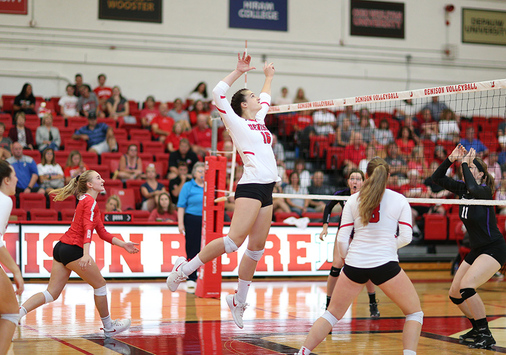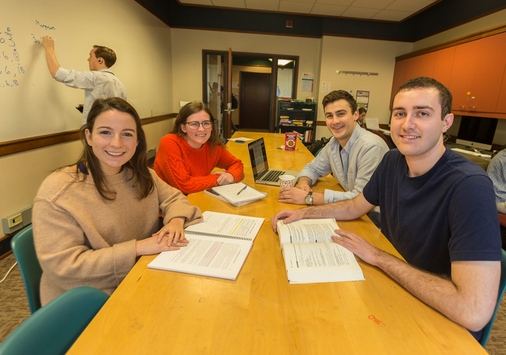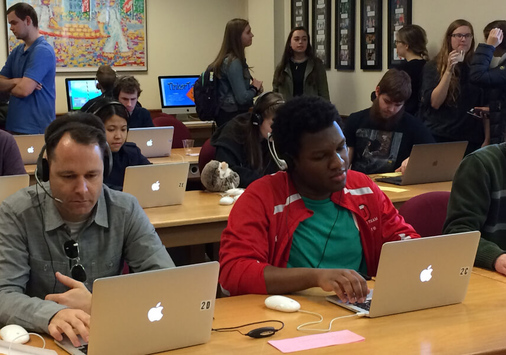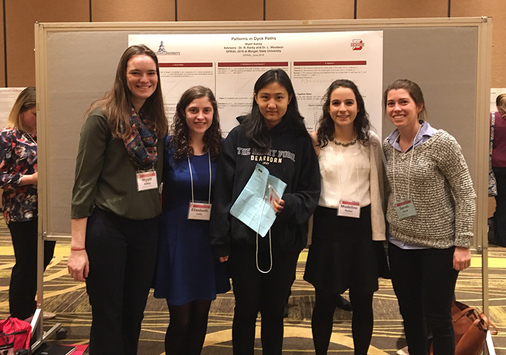Courses
2024 - 2025
For this academic year's course catalog, please visit our Academic Catalog site. For courses currently offered, please refer to the Schedule of Classes.
This course will explore three major topics of mathematics: linear algebra, probability and statistics, and Markov chains. Using these three topics, students will engage in three real world applications in biology, chemistry, and economics. This course is well suited for students who need a year of mathematics, like many pre-professional programs, and are looking for real applications of mathematics beyond the typical algebra and calculus approach. While this course would be a natural extension for pre-professional students who have taken Math 130 Essentials of Calculus, this course only requires a strong background in high school Algebra II.
An introduction to statistical reasoning and methodology. Topics include experimental design, exploratory data analysis, elementary probability, a standard normal-theory approach to estimation and hypothesis testing and linear and multi-variable regression. Not open for credit to students who have taken Psychology 370 or GC 202. Students who have received credit for MATH 220 may not subsequently receive credit for MATH 120.
A one-semester introduction to single-variable calculus for students who have not taken a calculus course. This class focuses on functions, graphs, limits, exponential, logarithmic and trigonometric functions, differentiation, integration, techniques and applications of integration, and applications from the natural and social sciences. Students who have received credit for MATH 135 or MATH145 may not subsequently receive credit for MATH130.
A one-semester single-variable calculus course starting from a knowledge of basic derivatives and integrals. This class focuses on advanced topic in derivatives, advanced topics in integrals, optimization, applications of calculus to the natural and social sciences, sequences and series, probability, and differential equations. Students who have received credit for MATH 145 may not subsequently receive credits for MATH 135.
Prerequisite(s): Placement or MATH 130.
A one-semester multivariable calculus course with an introduction to linear algebra. This class focuses on vectors, partial derivatives, gradients, optimization of functions of several variables, multiple integrals and their applications, and elementary linear algebra.
Prerequisite(s): Placement or MATH 135.
A general category used only in the evaluation of transfer credit.
A continued study of Linear Algebra with applications to linear differential equations and mathematical models in the physical and social sciences. Topics include abstract vector spaces over the real and complex numbers, bases and dimension, change of basis, the Rank-Nullity Theorem, linear transformations, the matrix of a linear transformation, eigenvectors and eigenvalues, diagonalization, matrix exponential, linear differential equations of order n, linear systems of first order differential equations, and a continued study of infinite series, power series, and series solutions of linear differential equations.
Prerequisite(s): MATH 145.
Statistics is the science of reasoning from data. This course will introduce the fundamental concepts and methods of statistics using calculus-based probability. Topics include a basic study of probability models, sampling distributions, confidence intervals, hypothesis testing, categorical data analysis, ANOVA, multivariate regression analysis, logistic regression, and other statistical methods. Scopes of conclusion, model building and validation principles, and common methodological errors are stressed throughout.
Prerequisite(s): MATH 135 and DA 101 or MATH 145.
Crosslisting: DA 220.
This course covers the essentials of asset management including the diversification of investment portfolios. The course begins with the basics of present value analysis and probability theory. Basic tools will be developed and used to study issues such as basic portfolio optimization and asset pricing.
Prerequisite(s): MATH 145.
A one semester overview of mathematics applied to physical systems, with extensive use of examples from introductory and intermediate physics. Topics covered include operators, functions, vectors, complex numbers, integration & differentiation in multiple dimensions, geometry (gradients, divergence, & curl), differential equations, and linear algebra. The unity of linear systems will be emphasized, though non-linearity will also be discussed. Both hand- and computer-aided computation will be required. NOTE: MATH 247 does not fulfill any requirements for the MATH major or minor.
Prerequisite(s): PHYS 121 or PHYS 126 and MATH 145 or consent.
Crosslisting: PHYS 201.
A general category used only in the evaluation of transfer credit.
An introduction to proof writing techniques. Topics will include logic and proofs, set theory, mathematical induction, relations, modular arithmetic, functions, cardinality, number theory, and calculus.
Prerequisite(s): MATH 145.
This course is the study of computers as mathematical abstractions in order to understand the limits of computation. In this course, students will learn about topics in computability theory and complexity theory. Topics in computability theory include Turing machines and their variations, the Universal Turing machine, decidability of the halting problem, reductions, and proving decidability of other problems. Topics in complexity theory include the classes P and NP, NP-completeness, and other fundamental complexity classes.This course is a study of formal languages and their related automata, Turing machines, unsolvable problems and NP-complete problems.
Prerequisite(s): CS 109, 110, CS 111, or CS 112, and MATH 300 or CS 234.
Crosslisting: CS 334.
This course aims to enhance mathematics and computer science students' proficiency and comfort in orally communicating content in their disciplines. Students will develop skills in presenting technical information to a non-technical audience. In particular, students will deliver a number of presentations during the semester on substantive, well-researched themes appropriate to their status in their major.
Prerequisite(s): MATH 210 or MATH 300, or CS 271.
Corequisite(s): a 300-level or higher mathematics or computer science course.
A general category used only in the evaluation of transfer credit.
This course is the study of counting techniques for discrete collections of objects. This course will include topics such as permutations and combinations, binomial coefficients, inclusion-exclusion, Fibonacci numbers, Catalan numbers, set partitions, Stirling numbers, generating functions, exponential generating functions, and Pólya counting.
Prerequisite(s): MATH 213 and MATH 300.
A rigorous analysis of the structure and properties of abstract groups, rings, fields, and vector spaces.
Prerequisite(s): MATH 213 and MATH 300.
This is a second course in linear algebra, which will continue to develop a linear algebra toolkit in order to pursue a mixture of theory and applications. Topics discussed will include singular value decomposition, canonical forms, orthogonal bases and inner product spaces, harmonic analysis and the discrete Fourier transform. The course will also include applications of these concepts in mathematics, computer science, and physics.
Prerequisite(s): MATH 213 and MATH 300.
This course involves mathematical modeling of real-world problems and the development of approaches to find optimal (or nearly optimal) solutions to these problems. Topics may include: modeling, linear programming and the simplex method, the Karush-Kuhn Tucker conditions for optimality, duality, network optimization, and nonlinear programming.
Prerequisite(s): CS 109, CS 110, CS 111, or CS 112, MATH 213, and MATH 220 or DA 220.
Crosslisting: CS 337.
This course is a survey of advanced statistical modeling techniques, building off the models studied in Applied Statistics, and introducing models based on more sophisticated mathematical structures such as matrices. The course emphasizes how to create, fit, test, and use statistical models in a variety of situations, and how to verify the conditions required for each model introduced. Course topics will be demonstrated via real-world applications, using the statistical computing language R to carry out the necessary computations. The selection of statistical models will depend on the instructor, but the course will contain elementary time series analysis regardless of who is teaching it. Other possible models include hierarchical linear models, longitudinal models, mixed models, Bayesian models, non-parametric models, statistical learning and data mining models, and principal component analysis.
Prerequisite(s): CS 109, CS 110, CS 111, CS 112, MATH 213 and MATH 220 or DA 220.
Statistics is the science of turning data into informed conclusions. The Bayesian approach to statistics uses probability theory to model both the uncertainty inherent in sampling from a population, and also our own degree of uncertainty in the answers we expect to get. That is, we begin with a prior distribution representing what we know or believe about a population, then we integrate new data that arrives into this distribution, resulting in a posterior distribution representing our updated beliefs. With this framework, an analysis can be informed by all past analyses on the topic (even if they analyzed other datasets), and we can construct an iterative approach that converges to the truth. This course introduces the Bayesian perspective, Bayesian approaches to statistical models you have seen in other classes, and new models that are only possible in the Bayesian approach. Course topics are demonstrated via real-world applications.
Prerequisite(s): MATH 220 or DA 220, and MATH 145, and CS 109, CS 110, CS 111 or CS 112.
Time series data is data that is sampled at several points in time. Such data is best analyzed with the tools of time series analysis. This course introduces numerous examples of, and exploratory data analysis techniques for, time series data. The course then covers the essential time series models, including ARIMA, SRIMA, Spectral Analysis, GARCH models, and the GLMM. We learn to fit these models via maximum likelihood estimation and numerical analysis techniques, how to verify the conditions required by each of the models, how to interpret the output of each model, and how to use the models for forecasting. After a detailed study of time series analysis, we will sample additional statistical modeling techniques in the latter half of the course. Course topics are demonstrated via real-world applications, using the statistical computing language R to carry out the necessary computations.
Prerequisite(s): CS 109, CS 110, CS 111, or CS 112, MATH 213, and MATH 220 or DA 220.
A study of single variable, multi-variable, and stochastic probability models with application to problems in the physical and social sciences. Includes problems in Biology, Finance, and Computer Science.
Prerequisite(s): CS 109, CS 110, CS 111, or CS 112, MATH 213, or MATH 220 or DA 220.
This course is about the design and analysis of randomized algorithms, (i.e. algorithms that compute probabilistically). Such algorithms are often robust and fast, though there is a small probability that they return the wrong answer. Examples include Google’s PageRank algorithm, load balancing in computer networks, coping with Big Data via random sampling, navigation of unknown terrains by autonomous mobile entities, and matching medical students to residencies. The analysis of such algorithms requires tools from probability theory, which will be introduced as needed. As there have been many randomized algorithms designed to solve problems on graphs, the course introduces numerous topics from graph theory of independent mathematical interest. Graphs are often used to mathematically model phenomena of interest to computer scientists, including the internet, social network graphs, and computer networks. Lastly, this course demonstrates the powerful Probabilistic Method to non-constructively prove the existence of certain prescribed graph structures, how to turn such proofs into randomized algorithms, and how to derandomize such algorithms into deterministic algorithms.
Prerequisite(s): CS 271 or MATH 435 or MATH 220 or DA 220, and MATH 300 and one from CS 109, CS 110, CS 111, or CS 112.
Crosslisting: CS 335.
A study of a widely used and applied subfield of advanced Linear Algebra and Calculus harnessing the power of orthogonal bases. For example, your ear processes a sound wave (maybe from plucking guitar strings) by changing into an orthogonal frequency basis allowing us to hear the main notes and some selected overtones. This course will use the power of changing bases, differentiation, and integration to analyze a wide array of problems in image processing, sound processing, signal reconstruction, medical imaging, wave analysis, heat diffusion, statistical modeling, quantum mechanics, number theory, and geometry. No knowledge of these application topics is necessary.
Prerequisite(s): CS 109, CS 110, CS 111, or CS 112, MATH 213, and MATH 220 or DA 220.
Differential equations arise in many areas of study. Indeed, any parameter that changes with respect to time may be described using a differential equation. This course covers both analytic and qualitative approaches to differential equations, as well as numerical methods. Topics may also include applications in biology, circuit theory, and mechanics.
Prerequisite(s): CS 109, CS 110, CS 111, or CS 112, and MATH 213 and MATH 220 or DA 220.
A course in mathematical modeling including linear and nonlinear optimization models, linear and non-linear dynamic models, and probability and statistical models. Both continuous and discrete models are considered. This course focuses on applying mathematics to open ended, real world problems, and effectively communicating conclusions. Sensitivity analysis and model robustness are emphasized throughout. This course also strongly features approximation and simulation methods in conjunction with analytic methods.
Prerequisite(s): CS 109, CS 110, CS 111, or CS 112, and MATH 213, and MATH 220.
A rigorous analysis of limits, continuity, differentiation, integration, uniform convergence, infinite series and basic topology.
Prerequisite(s): MATH 213 and MATH 300.
A study of general topological spaces, including interiors, closures, boundaries, subspace, product, and quotient topologies, continuous functions, homeomorphisms, metric spaces, connectedness, and compactness together with applications of these concepts. Additional topics may include algebraic topology, including homotopy and homology groups, and/or a parallel study of general measure spaces, including inner and outer measure.
Prerequisite(s): MATH 213 and MATH 300.
A study of the complex plane and functions of complex variables. Topics include analytic functions, derivatives, singularities, integrals, Taylor series, Laurent Series, conformal mappings, residue theory, analytic continuation, Cauchy-Riemann equations, Cauchy’s Theorem, the Cauchy Integral Formula, Picard’s Theorems, the Riemann Mapping Theorem, and Rouche's Theorem.
Prerequisite(s): MATH 213 and MATH 300.
Special topics offered at an advanced level not covered in regular courses.
Advanced topics in Abstract Algebra, Analysis, Geometry or Applied Math.
This course is a capstone experience in oral and written communication for mathematics and computer science majors. Students will research a substantive topic, write a rigorous expository article, and make a presentation to the department.
Prerequisite(s): MATH 395 or CS 395 and a 300-400 level computer science course or a 400-level mathematics course.
A general category used only in the evaluation of transfer credit.














